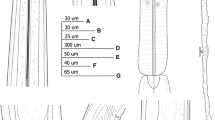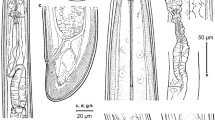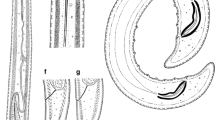Abstract
A needle nematode of the genus Paralongidorus was isolated from Cuban royal palm (Roystonea regia) in China. Detailed morphological study confirmed that this species was the described needle nematode P. sacchari. Accordingly it was formally described and photographed. This nematode is characterised by a long body (4348–5825 μm), a board and anteriorly flat lip region slightly offset from body contour, bearing a stirrup-shaped amphidial fovea, with conspicuous slit-like aperture, a long and flexible odontostyle ca 101–110 μm long, stylet guiding ring located at 27.5–33.0 μm from anterior end, vulva near mid-body (48.0–50.0%), a short dorsally convex tail, with rounded terminus, and male absent. Molecular characterisation using near full-length 18S rRNA and D2-D3 expansion segments of 28S rRNA gene was also provided. Phylogenetic trees inferred from BI analysis of the two rRNA gene fragments revealed that P. sacchari could be distinguished from all described needle nematodes with molecular data, as well as the closely related species P. bikanerensis and P. sali. This nematode is a new record of Paralongidorus species from China. Cuban royal palm is a new host plant for P. sacchari.





Similar content being viewed by others
References
Andrássy, I. (1986). A new needle nematode species from Hungary, Paralongidorus rex sp. n. (Nematoda: Longidoridae) (Vol. 73, pp. 115–118). Állattani Kozlemények.
Barsalote, E. M., Tian, Z. L., Cai, R. H., Li, X. L., & Zheng, J. W. (2018). Description of two new records of genus Longidorus (Nematoda: Dorylaimida) in China. Journal of Zhejiang University (Agriculture & Life Science), 44(1), 31–40.
Barsi, L., & Luca, F. D. (2017). Morphological and molecular characterisation of Paralongidorus francolambertii sp. n. (Nematoda: Longidoridae) from Serbia. Nematology, 19(6), 681–695.
Baujard, P. (1989). Remarques sur les genres des sous-familles Bursaphelenchinae Paramonov, 1964 et Rhadinaphelenchinae Paramonov, 1964 (Nematoda: Aphelenchoididae). Revue de Nématologie, 12, 323–324.
Brown, D. J. F., & Boag, B. (1988). An examination of methods used to extract virus-vector nematodes (Nematoda: Longidoridae and Trichodoridae) from soil samples. Nematologia Mediterranea, 16, 93–99.
Bütschli, O. (1874). Zur Kenntnis der freilebenden Nematoden, insbesondere der des Kieler Hafens. Abhandl. d. Senckenb. naturf. Gesellsch, 9, 237–292.
Cai, R., Maria, M., Qu, N., Castillo, P., & Zheng, J. (2018). Morphological and molecular characterization of Paralongidorus sali Siddiqi, Hooper, and Khan, 1963 with a description of the first-stage juvenile and male of Longidorus jonesi Siddiqi, 1962 from China. Journal of Nematology, 50(3), 419–436.
Chuo, S. K., & Wouts, W. M. (1977). Royal Palm, Roystonea regia (HBK) cook, a new host of the burrowing nematode Radopholus similis (Cobb, 1893) Thorne, 1949. Singapore Journal of Primary Industries, 5, 91–95.
Cobb, N. A. (1893). Nematodes, mostly Australian and Fijian. In J. J. Fletcher (Ed.), Macleay memorial volume (pp. 252–308). Sydney: The Linnean Society of NSW.
Cobb, N. A. (1919). A newly discovered nematode (Aphelenchus cocophilus, sp. n.) connected with a serious disease of the coconut palm. West Indian Bulletin, 17(4), 203–210.
Coomans, A. (1985). A phylogenetic approach to the classification of the Longidoridae (Nematoda: Dorylaimida). Agriculture, Ecosystems and Environment, 12(4), 335–354.
Coomans, A. (1996). Phylogeny of the Longidoridae. Russian Journal of Nematology, (4), 51–60.
De Ley, P., Felix, M. A., Frisse, L. M., Nadler, S. A., Sternberg, P. W., & Thomas, W. K. (1999). Molecular and morphological characterisation of two reproductively isolated species with m irror-image anatomy (Nematoda: Cephalobidae). Nematology, 1(6), 591–612.
Decraemer, W., & Coomans, A. (2007). Revision of some species of the genus Paralongidorus sensu Siddiqi et al. (1993), with a discussion on the relationships within the family Longidoridae (Nematoda: Dorylaimida). Nematology, 9(5), 643–662.
Decraemer, W., & Robbins, R. T. (2007). The who, what and where of Longidoridae and Trichodoridae. Journal of Nematology, 39(4), 295.
Escuer, M., & Arias, M. (1997). Paralongidorus iberis sp. n. and P. monegrensis sp. n. from Spain with a polytomous key to the species of the genus Paralongidorus Siddiqi, Hooper & Khan, 1963 (Nematoda: Longidoridae). Fundamental and Applied Nematology, 20(2), 135–148.
FAO (2009). Study on the identification and population density of plant parasitic nematodes associated with date palm in the south of Iran [2006]. http://agris.fao.org/agris-search/search.do?recordID=IR2008001073. Accessed 23 October 2018.
Goodey, J., Franklin, M. T. H., & David, J. (1965). The nematode parasites of plants catalogued under their hosts (3rd ed.). Farnham Royal: Commonwealth Agricultural Bureaux.
Gutiérrez-Gutiérrez, C., Rius, J. E. P., Cantalapiedra-Navarrete, C., Landa, B. B., & Castillo, P. (2011). Prevalence, polyphasic identification, and molecular phylogeny of dagger and needle nematodes infesting vineyards in southern Spain. European Journal of Plant Pathology, 129(3), 427–453.
Gutiérrez-Gutiérrez, C., Mota, M., Castillo, P., Santos, M. T., & Palomares-Rius, J. E. (2018). Description and molecular phylogeny of one new and one known needle nematode of the genus Paralongidorus (Nematoda: Longidoridae) from grapevine in Portugal using integrative approach. European Journal of Plant Pathology, 151(1), 155–172.
Heyns, J. (1965). New species of the genera Paralongidorus and Longidorus (Nematoda: Dorylaimoidea) from South Africa. South African Journal of Agricultural Science, 8, 863–874.
Holterman, M., van der Wurff, A., van den Elsen, S., van Megen, H., Bongers, T., Holovachov, O., Bakker, J., & Helder, J. (2006). Phylum-wide analysis of SSU rDNA reveals deep phylogenetic relationships among nematodes and accelerated evolution toward crown clades. Molecular Biology and Evolution, 23(9), 1792–1800.
Huelsenbeck, J. P., & Ronquist, F. (2001). MR BAYES: Bayesian inference of phylogenetic trees. Bioinformatics, 17(8), 1754–1755.
Khan, E. (1981). Inagreius gloriosus gen. N., sp. n. and descriptions of three new species of Xiphinema Cobb, 1913 along with report on X. radicicola T. Goodey, 1936 and X. elongatum Sch. Stek. & Teun., 1938 (Nematoda: Longidoroidea) from India. Indian Journal of Nematology, 11(2), 189–204.
Khan, E., Seshadri, A. R., Weischer, B., & Mathen, K. (1971). Five new nematode species associated with coconut in Kerala, India. Indian Journal of Nematology, 1(2), 116–127.
Khan, E., Chawla, M. L., & Saha, M. (1978). Comments on the classification of the Longidoroidea (Nematoda) with description of three new species. Indian Journal of Nematology, 6(1), 47–62.
Khan, A., Saeed, M., Ali, T., & Khanaum, M. (1989). Efficacy of Tenekil against needle nematode Paralongidorus citri (Siddiqi, 1959) Siddiqi et al., 1963 associated with coconut palm (Cocos nucifera). Proceedings of Parasitology, (7/8), 202–205.
Larget, B., & Simon, D. L. (1999). Markov chain Monte Carlo algorithms for the Bayesian analysis of phylogenetic trees. Molecular Biology and Evolution, 16, 750–759.
Meador, M., & Wu, X. (2011). People's Republic of China: Updated list of quarantine harmful bio-organisms. Global Agricultural Information Network Report Number CH11051. Washington, DC: USDA Foreign Agricultural Service.
Mundo-Ocampo, M., Troccoli, A., Subbotin, S. A., Cid, J., Baldwin, J. G., & Inserra, R. N. (2008). Synonymy of Afenestrata with Heterodera supported by phylogenetics with molecular and morphological characterisation of H. koreana comb. n. and H. orientalis comb. n. (Tylenchida: Heteroderidae). Nematology, 10(5), 611–632.
Page, R. D. M. (1996). TreeView: An application to display phylogenetic trees on personal computers. Computer Applications in the Biological Sciences, 12, 357–358.
Palomares-Rius, J. E., Subbotin, S. A., Landa, B. B., Vovlas, N., & Castillo, P. (2008). Description and molecular characterisation of Paralongidorus litoralis sp. n. and P. paramaximus Heyns, 1965 (Nematoda: Longidoridae) from Spain. Nematology, 10(1), 87–101.
Palomares-Rius, J. E., Cantalapiedra-Navarrete, C., GutiérrezGutiérrez, C., Liébanas, G., & Castillo, P. (2013). Morphological and molecular characterisation of Paralongidorus plesioepimikis n. sp. (Nematoda: Longidoridae) from southern Spain. Nematology, 15, 363–378.
Pedram, M., Pourjam, E., Namjou, S., Atighi, M. R., Cantalapiedra-Navarrete, C., Liébanas, G., PalomaresRius, J. M., & Castillo, P. (2012). Molecular and morphological characterisation of Paralongidorus iranicus n. sp. and P. bikanerensis (Lal & Mathur, 1987) Siddiqi, Baujard & Mounport, 1993 (Nematoda: Longidoridae) from Iran. Nematology, 14(4), 427–443.
Posada, D., & Crandall, K. A. (1998). Modeltest: Testing the model of DNA substitution. Bioinformatics, 14(9), 817–818.
Roca, F., & Rios, A. (2006). Paralongidorus sacchari Siddiqi, Hooper & Khan, 1963 and Paraxiphidorus michelluci Coomans & Chaves, 1995 (Nematoda: Longidoridae) from Chile. Nematology, 8(4), 619–625.
Seinhorst, J. W. (1959). A rapid method for the transfer of nematodes from fixative to anhydrous glycerin. Nematologica, 4, 67–69.
Siddiqi, M. R. (1959). Studies on Xiphinema spp. (Nematoda: Dorylaimoidea) from Aligarh (North India), with comments on the genus Longidorus Micoletzky, 1922. Proceedings of the Helminthological Society of Washington, 26(2), 151–163.
Siddiqi, M. R. (1964). Xiphinema conurum n. sp. and Paralongidorus microlaimus n. sp. with a key to the species of Paralongidorus (Nematoda: Longidoridae). Proceedings of the Helminthological Society of Washington, 31(2), 133–137.
Siddiqi, M. R., Hooper, D. J., & Khan, E. (1963). A new nematode genus Paralongidorus (Nematoda: Dorylaimoidea) with descriptions of two new species and observations on Paralongidorus citri (Siddiqi 1959) n. comb. Nematologica, 9(1), 7–14.
Siddiqi, M. R., Baujard, P., & Mounport, D. (1993). Descriptions of Paratylenchus pernoxius sp. n. and Paralongidorus duncani sp. n. from Senegal, and the synonymization of Longidoroides with Paralongidorus. Afro-Asian Journal of Nematology, 3(1), 81–89.
Swofford, D. L. (1998) PAUP*-phylogenetic analyses using parsimony (* and other methods). Version 4 b10. Sunderland: Sinauer Associates, 128 pp.
Tamura, K., Stecher, G., Peterson, D., Filipski, A., & Kumar, S. (2013). MEGA6: Molecular evolutionary genetics analysis version 6.0. Molecular Biology and Evolution, 30(12), 2725–2729.
Taylor, C. E., & Brown, D. J. F. (1997). Nematode vectors of plant viruses (296 pp). Wallingford, UK: CABI.
Thorne, G. (1949). On the classification of the Tylenchida, new order (Nematoda, Phasmidia). Proceedings of the Helminthological Society of Washington, 16(2), 37–73.
Tulaganov, D. A. (1937). Nematoden der Tomate und des sie umgebenden Bodens. Zoologischer Anzeiger, 118, 283–285.
Xu, Y., Ye, W., Wang, J., & Zhao, Z. (2018). Morphological and molecular characterisation of Longidorus pinus sp. n. (Nematoda: Longidoridae) from China and a key to known species of Longidorus in China. Nematology, 20(7), 617–639.
Zhuo, K., Cui, R. Q., Ye, W. M., Luo, M., Wang, H. H., Hu, X. N., & Liao, J. L. (2010). Morphological and molecular characterization of Aphelenchoides fujianensis n. sp. (Nematoda: Aphelenchoididae) from Pinus massoniana in China. Zootaxa, 2509, 39–52.
Acknowledgements
This research was supported by the Forest Science and Technology Innovation Project of Guangdong Province (Grant number 2015KJCX045) and the Youth Innovation Talent Project founded by Department of Education of Guangdong Province (grant number 2017GkQNCX051).
Author information
Authors and Affiliations
Corresponding author
Ethics declarations
Conflict of interest
The authors declare that they have no conflict of interest.
Human and animal rights
The article does not contain any studies with human or animal subjects performed by any of the authors.
Informed consent
Informed consent was obtained from all individual participants included in the study.
Rights and permissions
About this article
Cite this article
Wang, H., Zhuo, K., Cai, R. et al. Morphological and molecular characterisation of Paralongidorus sacchari (Nematoda: Longidoridae), a new record of needle nematode in China. Eur J Plant Pathol 155, 615–625 (2019). https://doi.org/10.1007/s10658-019-01796-x
Accepted:
Published:
Issue Date:
DOI: https://doi.org/10.1007/s10658-019-01796-x




